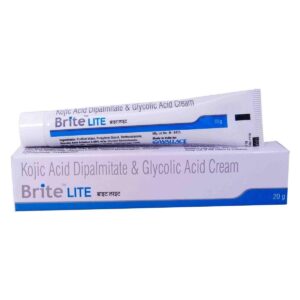GLYCOLIC ACID + KOJIC ACID
Glycolic Acid: Glycolic acid is a medication that belongs to the class of alpha hydroxy acids (AHAs). It is commonly used as a topical treatment for various skin conditions, including acne, hyperpigmentation, and signs of aging. Glycolic acid is also used in chemical peels to exfoliate the skin and promote cell turnover.
The mechanism of action of glycolic acid involves its ability to penetrate the skin and dissolve the “glue” that holds dead skin cells together. This exfoliation process helps to unclog pores, remove dead skin cells, and stimulate the production of collagen and elastin, leading to smoother, brighter skin.
The dose of glycolic acid varies depending on the specific product and the condition being treated. It is essential to follow the instructions provided by the healthcare professional or the product label.
Some common side effects of glycolic acid include mild skin irritation, redness, dryness, and peeling. These side effects are usually temporary and resolve with continued use. However, if severe or persistent irritation occurs, it is advisable to discontinue use and consult a healthcare professional.
It is worth noting that glycolic acid increases the skin’s sensitivity to sunlight, so it is essential to apply sunscreen with a high SPF during and after using products containing glycolic acid. Additionally, individuals with sensitive skin may need to start with a lower concentration of glycolic acid to minimize the risk of adverse reactions.
As with any medication, it is recommended to consult a healthcare professional before starting glycolic acid treatment, especially for individuals with pre-existing skin conditions or those taking other topical medications.
Kojic Acid: Kojic Acid is a natural compound that is derived from several fungi species, including Aspergillus oryzae, which is commonly found in fermented foods like rice wine and soy sauce. It is widely used in the cosmetic industry as a skin-lightening agent and is also used in the treatment of certain skin conditions.
The primary use of Kojic Acid is as a skin-lightening agent to reduce the appearance of dark spots, uneven skin tone, and hyperpigmentation. It works by inhibiting the production of melanin, the pigment responsible for skin color. By blocking the enzyme tyrosinase, which is involved in melanin synthesis, Kojic Acid effectively lightens the skin. It is also known for its antioxidant properties, which may help protect the skin from damage caused by free radicals.
Kojic Acid is available in various forms such as creams, lotions, soaps, and serums. The appropriate dose and application method can vary depending on the specific product and individual needs. It is important to follow the instructions provided by the manufacturer or consult a dermatologist for proper usage guidelines.
While generally considered safe when used as directed, Kojic Acid can have some side effects. These side effects may include skin irritation, redness, itching, and dryness. In rare cases, individuals may experience allergic reactions such as swelling, rash, or difficulty breathing. It is advisable to do a patch test before first-time use to check for any adverse reactions.
Some individuals may be more prone to sensitivity and should exercise caution when using Kojic Acid. These include those with sensitive skin, allergies, or a history of skin reactions. It is also recommended to avoid sun exposure while using Kojic Acid, as it can increase the risk of sunburn.
As with any cosmetic or skincare product, it is important to consult with a healthcare professional or dermatologist before starting the use of Kojic Acid, especially if you have any underlying skin conditions or are using other topical medications. They can provide personalized advice and guidance to ensure safe and effective usage.

